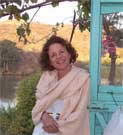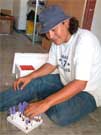By ELIZABETH PISANI
1092 words
14 March 1996
<
Asia Times
English
(c) 1996 Chamber World Network International Ltd
"No weapons or explosives allowed inside. Please leave with security," reads the sign at the door. A nightclub, perhaps? No, this is Cambodia's central bank.
The sign reflects something of the cowboy atmoshpere of Cambodia's banking industry. Twenty-nine banks, nine of them foreign, fight for a slice of the country's tiny economy. They offer sky-high interest rates on US dollar deposits, hoping to recoup their money by lending it out at even more astronomical rates.
The National Bank of Cambodia plans to build up its arsenal to fight the cowboys, but its hands are tied by the fact that the local currency, the riel, is used only for small change. Thai baht and Vietnamese dong are widely circulated, but the greenback is king.
Bankers estimate that 98 percent of the banking system is in US dollars, and the picture in the vast cash economy is little different. By using dollars, Cambodia is essentially underwriting the United States budget deficit. "For poor countries like this one to be subsidising the United States is absurd," said a senior adviser to the central bank.
People use US dollars for several reasons, not least because until recently the largest local currency denomination was 500 riel (about US$0.20), so any payment in riel meant counting out towering piles of grubby red notes.
More importantly, people use US dollars because their trust in the local currency has been undermined. "I can understand it on an individual level, but on a national level it is a monumental idiocy," said the central bank adviser.
In theory, foreign exchange is strictly controlled by the central bank under a 1991 law that obliges people to convert foreign currencies into riel. In practice, government agencies refuse to accept local currency payments even for things as simple as visa fees.
The central bank hopes the government will soon start setting the example by collecting its budget revenues in local currecy. "But the de-dollarization will be a very slow process," said Che Shok, head of the National Bank's research department. "We want first to create a stable macroeconomic environment."
This leaves policy makers with a chicken-and-egg question. Current economic wisdom supplied by organizations such as the International Monetary Fund holds that control of the money supply is key to macroeconomic stability. But if the country's currency of choice is printed not by the National Bank of Cambodia but by the Federal Reserve Bank of the United States, such control is all but impossible.
The central bank plans soon to issue treasury bills in riel, and is considering making it obligatory for banks to buy them. That would create a demand for riel among banks. Theoretically they would then have to seduce the public with high interest rates into holding riel deposits, in turn dissuading them from rushing out to convert all their riel to dollars.
Theoretically. But theory and practice are poles apart. "You can't just take the financial structure of other Asian countries and lay it over the Cambodian framework," said the manager of an Asian bank in Phnom Penh. "It is too full of holes, and some are very big. For now, talk of T-bills and secondary markets is just mumbo-jumbo."
In truth, some Cambodian banks already offer dollar interest rates that would make depositors elsewhere drool. Several small banks offer rates of up to 10.5 percent for dollars deposited for a year, three times what investors could hope to get at a blue-chip bank in most Asian cities. And still the vast majority of people's dollars - three quarters by some economists' guesstimates - remain outside the banking system.
The reluctance to put money in the bank is born of a recent history racked with coups, revolutions and invasions. "I always get asked, what if something happens at the weekend? Can I withdraw my money from Hong Kong, or Malaysia, or somewhere?" an international banker said.
Some bankers said it was just as well high deposit rates did not bring in more money. They have trouble enough finding ways to use the money they have. Banks that borrow at eight percent or more will not lend at less than 18 percent. No one in their right minds would borrow at those rates if they could get money on the international markets at half that, so the big international investors in Cambodia just bring their money with them.
And no one could afford to borrow at those rates unless they were making great returns. "They must be making returns of 40 percent. How they do that, I just don't know," said Cambodia Mekong Bank's executive vice-president, Boun Chhay Khouv.
To some economists, it is a no-brainer. "You put it in to some speculative investment, which must of course be high risk, and which probably doesn't produce anything or create any jobs. Perhaps you can sustain that for a while, but not for long," said an international economic adviser.
Although the more conservative local banks offer deposit rates much closer to international norms, they are struggling to stay afloat while staying away from the shakiest of the speculative investments. "We are one of the strongest banks, and we are in the red," said Boun Chhay Khouv.
Bankers who have been on the scene for a while find it hard to understand the fuss. The 18-plus percent the banks charge is dwarfed by black market rates of around 30 percent a year, and until recently the black market was all there was. "People are still borrowing US$10,000 on the black market and putting it into nightclubs, taxi girls (prostitutes), not serious business," said Pung Kheav Se, general manager of the Canadia Bank. "(Money-lenders) don't take collateral, but you would not like to argue with their collection teams."
Aware that only a small proportion of their lending is to productive industries, sensible bankers are big on liquid assets. Many keep between 45 and 55 percent of their funds sleeping in banks in Hong Kong or elsewhere. This raises pressure on them to mark up the money they do lend out, churning it through short-term, high-risk loans as fast as possible.
"A lot of banks are looking beyond the short term," said Boun Chhay Khouv. "But we do have to survive though the short term. That is the difficulty."
Copyright 1996 Asia Times.
(c) 1996 Chamber World Network International Ltd.




